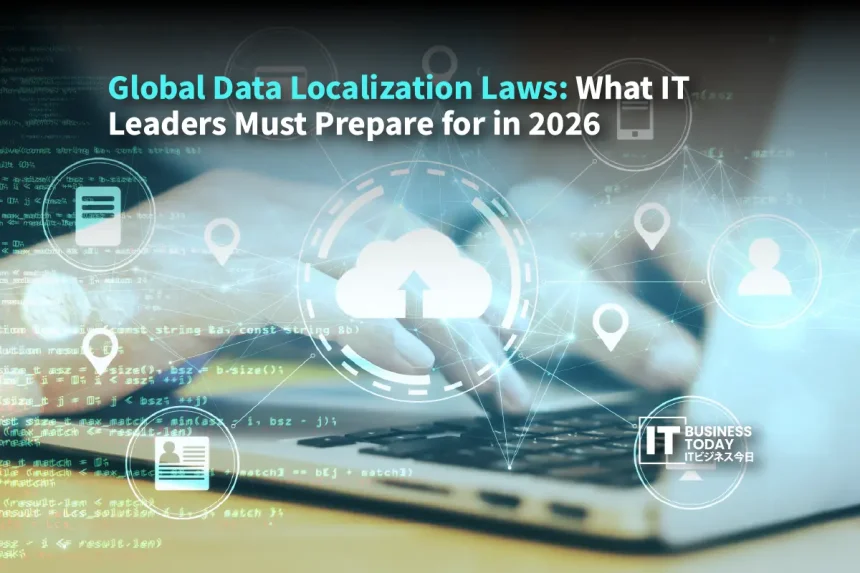グローバリゼーションとは、かつてはスピードと効率のことでした。今はコントロールが重要。デジタル主権が新しいルールです。企業はデータがどこに存在し、誰がそれにアクセスできるのかを考えなければなりません。.
データのローカライゼーションは簡単です。データが特定の場所に留まらなければならないということです。データ主権とは、法律と誰が法的に管理するかということです。どちらも重要です。どちらもITシステムの構築方法に影響します。.
2026年までに、世界は様変わりするでしょう。これまでグローバルだったクラウドシステムは、地域ごとの設定が必要になるでしょう。企業はインフラに最初からコンプライアンスを設計しなければならなくなるでしょう。.
EUはこれを現実のものにしました。その データ法 2025年9月12日に適用開始。欧州で生成されたデータへのアクセスを規制。共有は奨励されますが、データの保存場所に関するルールも強化されます。これを無視する企業は問題に直面するでしょう。.
これらのシフトを理解することはオプションではありません。IT、戦略、法務の各チームが協力しなければなりません。時間は刻一刻と迫っています。.
2026年の規制スペクトラム
世界中のデータ規則が厳しくなっています。ITチームはもうグローバルな1つのセットアップに頼ることはできません。国によっては厳しいローカライゼーションが要求されます。例えば中国やロシアは、特定のデータを自国内に留めることを要求しています。つまり、企業は生産システムを分離しなければなりません。ルールに違反すれば、業務が停止する可能性もあります。.
他のリージョンでは、制限付きでデータの移動が可能です。これは条件付き処理と呼ばれます。これは EU はこれをよく示しています。2025年5月、欧州委員会、理事会、議会はGDPRの執行を更新しました。国境を越えたケースは、より迅速かつ明確に処理されます。ITチームはすべての移転を追跡し、規則に従っていることを確認しなければなりません。多少の柔軟性はありますが、義務は厳格です。.
法律によっては特定の分野に焦点を当てたものもあります。これが分野別ローカライゼーションです。インドのDPDP法は、医療記録や財務情報など、特定の種類のデータを対象としています。企業はどのルールが適用されるかを把握し、それに応じてシステムを調整する必要があります。.
これらのルールを理解することが重要です。早期に準備を始めた企業は、ローカルルールに従ったシステムを構築しながら、グローバルに事業を展開することができます。2026年までに迅速に対応する企業は、混乱に直面することが少なくなり、コストを削減することができます。.
グローバル 情報技術 チームは今すぐ行動を起こす必要があります。これらの違いを無視することは危険です。ローカライゼーションをコストとしてではなく、戦略として捉えましょう。早期に適応した企業は、規制当局、パートナー、顧客との信頼関係を強化し、よりスムーズな道を歩むことができます。.
こちらもお読みください: 日本のサイバー防衛の推進:量子主導の脅威への備え
アーキテクチャとサプライチェーンのジレンマ
ITチームはデータに関するより大きな課題に直面しています。グローバル クラウド リージョンからローカルなエッジベースのデータセンターへの移行は容易ではありません。企業はもはや地域間でデータをコピーすることはできません。ローカルルールを満たすために、データは特定の場所にとどまる必要があります。このため、インフラへの負荷が高まり、クラウド戦略の見直しが迫られます。チームは、どのワークロードを中央に残し、どのワークロードをローカルにするかを決定する必要があります。計画が重要です。.
最初のステップはデータのマッピングです。組織は、どのようなデータを持っているかを知らなければなりません。また、そのデータの機密性、出所、適用される法律も把握しておかなければなりません。これがなければ、ルールが破られ、機密データが漏洩する可能性があります。データマッピングと分類はもはやオプションではありません。コンプライアンス重視のクラウド戦略の基盤なのです。.
ベンダーとSaaSの監視がさらに複雑さを増しています。ITリーダーは自社のシステムだけに頼ることはできません。クラウド・プロバイダー、SaaSアプリ、サブ・プロセッサーはすべて、その地域の居住規則に従わなければなりません。契約書のチェックが必要です。ポリシーの見直しが必要です。監査が必要な場合もあります。コンプライアンスに違反するベンダーが1社でもあれば、企業は危険にさらされます。.
こんなツール Google Cloudの保証されたワークロード ヘルプデータがどこに保存されているかを示すものです。企業は場所を選択し、権限を管理することができます。そのため、保存規則を守ることが容易になります。ITチームはデータをコンプライアンスに準拠させながら、クラウドサービスを効率的に利用することができます。.
2026年、ITチームは多くのことに直面。インフラは厄介。データマッピングも厄介。ベンダーはさらに頭痛の種を増やします。コスト、パフォーマンス、コンプライアンスはすべて異なる方向に引っ張られます。データのローカライゼーションを無視すれば、遅延、罰金、厄介なオペレーションが発生します。.
賢いチームは事前に計画を立てています。どのようなデータを持っているかを把握しそれを慎重に整理します。すべてのベンダーをチェックします。Google CloudのAssured Workloadsのようなツールが役立ちます。適切な場所を選び、権限を管理し、データをあるべき場所に保管します。.
これをすれば、オペレーションは継続します。これを怠れば、問題が発生します。簡単なことです。.
コンプライアンス・バイ・デザインのフレームワーク構築

データローカリゼーションは現実。企業は待っていられません。ITチームは最初からルールに従ったシステムを計画しなければなりません。一つの方法は、データ・メッシュやレイクハウス・セットアップを利用することです。データを製品のように扱うこと。データは各チームが所有。各リージョンはそれぞれのデータを処理できます。セントラルチームは全体像を把握。これにより、全員の業務スピードを落とすことなく、コンプライアンスを維持することができます。.
暗号化、トークン化、仮名化が鍵です。これらはデータの移動や使用中にデータを保護します。毎回の法的承認は必要ありません。機密情報を安全に保護します。システムの動作が速くなります。チームが弁護士に妨害されることもありません。.
自動化は必須。同意、ポリシー、モニタリングにはツールが必要です。手作業ではすべてを把握することはできません。コードによって自動的にルールが適用されます。問題は罰金になる前に発見されます。.
ルールにはお金がかかります。節約にもなります。A 2025 OECD 報告書は経済性を検討しました。余分なインフラやプロセスの遅れは明らかなコストです。しかし、メリットもあります。管理の向上。罰則のリスクの軽減。パートナーや顧客からの信頼の向上これを知ることで、チームは予算を立て、投資先を決定することができます。.
プランニング, テック, とガバナンスは連動しなければなりません。ルールを考慮したシステム構築テクニカルコントロールによるデータ保護モニタリングの自動化予算と戦略を追加します。これを早期に行うことで、後々の頭痛の種を避けることができます。.
完璧ではありません。チームはミスを犯すでしょう。コンプライアンスを守らないベンダーもいるでしょう。プロセスが遅くなることもあるでしょう。しかし、今始めることで、よりコントロールしやすくなります。オペレーションはよりスムーズに。リスクは減少します。コンプライアンスは副次的な作業ではなく、会社の業務の一部となります。.
データのローカライゼーションはあらゆるものに影響します。アーキテクチャ技術的な選択。戦略。財務。無視するという選択肢はありません。ITと ビジネス チームはこれを計画の中核として扱う必要があります。早い段階からそれを正しく理解しているチームは、2026年以降も、より早く動き、ペナルティを回避し、信頼を得ることができるでしょう。.
2026年準備チェックリストと財務予測
企業はギリギリまで待つことはできません。2025年第4四半期から2026年第4四半期にかけて、ITチームは行動を起こす必要があります。最初のステップは、すべてのデータをマッピングすることです。データを把握すること。データの所在を知ること。どの法律が適用されるかを知ること。次に、クラウドとローカル・インフラストラクチャの予算を確定します。どこにいくら使うかを決めます。次に、規制当局による監査を実施します。システムをチェック。ベンダーをチェック。抜け漏れがないように。.
支出は単なるコストではありません。保険です。OPEX、CAPEX、その両方を計画しましょう。今コンプライアンスを構築することで、後の大きな問題を防ぐことができます。罰金、遅延、業務の中断。前もってお金をかけることで、長期的にはより多くのお金を節約することができます。.
AWSはこれがいかに深刻かを示しています。2024年、AWSは 78億ユーロ 欧州ソブリン・クラウド向け。2025年末までにドイツ・ブランデンブルクに最初の地域を開設。これは現金以上のものです。データレジデンシーへのコミットメントです。企業はこれを参考にすることができます。早期の投資。必要に応じてローカルリージョンを構築。ルールで強制される前に、システムがレジデンシー要件を満たしていることを確認。.
準備はオプションではありませんデータのマッピング。予算の計画。システムの監査。コンプライアンスを維持するためのツールと戦略。これを実行するチームは、頭痛の種を回避し、コストを削減し、データのローカライゼーションが譲れない世界で業務を円滑に進めることができます。.
グローバルな信頼のためのデータ管理

データのローカライゼーションがすべてを変えます。IT部門はもうスピードやコストだけを考えることはできません。ルール、リスク、信頼が重要なのです。誰がデータを見ることができるのか?データの保存場所データの保護方法。これらすべてが重要です。.
これをチャンスと捉えた企業が、2026年にはより良い結果を残すでしょう。ローカリゼーションを賢く利用することで、システムはより強固になります。システムの信頼性を高めます。パートナー、規制当局、顧客との信頼関係を構築します。ローカリゼーションを無視すれば、遅れをとることになります。.
これは単なるITの仕事ではありません。取締役会やC-suiteが決定しなければなりません。アーキテクチャ、予算、コンプライアンス、これらすべてにトップの注意が必要です。.
今すぐ始めましょう。計画、整理、チェック。システムを準備しましょう。ペナルティを回避。業務を円滑に。信用を築きましょう。.
データのローカライゼーションは守るべきルールではありません。基礎なのです。信頼、強さ、そして成長のための基盤です。.







